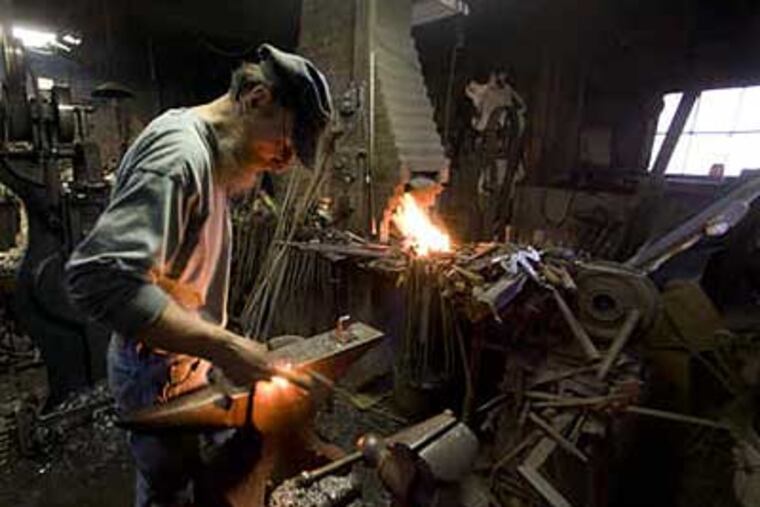This blacksmith forges works of art
Some of the reproductions crafted by Chester County's James Kieffer look so original they've been mistaken for antiques.

James Kieffer has been a blacksmith for nearly 40 years. He scoffingly calls himself "semiretired." At age 66, he works six days a week and most days is at his forge at least 10 hours.
Lean and wiry, he exhibits none of the brawn of the village smithy of poetic lore. Like the Amish farmers who till the surrounding fields on the outskirts of Honey Brook, Chester County, he shows his industry not in bulging muscle but sinewy stamina.
Although horse-drawn buggies pass by regularly, Kieffer does not shoe steeds. Instead, he makes mostly house hardware - reproductions of 18th-century latches and hinges and such - for restoration contractors and specialty suppliers.
Some of his pieces look so original they've been mistaken for antiques. Last winter, one of Kieffer's Chester County roasting forks, after passing through other hands, fetched $31,000 at Sotheby's.
Nimbly, he straddles the line between craftsman and artist. Over the years, he has fabricated candle stands and andirons and fireplace cranes, trivets shaped like snakes, and Bowie knives and tomahawks for reenactors.
His pipe tongs, for plucking an ember and placing it in the bowl of a pipe, are beautiful and ingenious. His kitchen utensils are examples of "whitesmithing," befitting a jeweler. His wedding forks are ornamented with heart-shaped tines and brass inlay in a vine-and-berry pattern.
Fellow blacksmiths hold him in high esteem. Not only is he a superb mechanic, but he also has "the eye" - an innate feel for design and proportion.
"His historic blacksmith work is exceptional," says Kelly Smyth, who practices the craft at the Newlin Grist Mill. "Smiths who can forge traditional hardware and understand it to the point of having their work taken as 'antique' are few and far between.
"He's made thousands of bean latches, so an individual example doesn't have to be 'perfect,' nor are the originals he's copying," Smyth said. "His skills at the anvil give him a quiet confidence gained only by years of experience and accomplishment."
Kieffer makes the recesses for inlays with punches he shapes, files and tempers himself. He beats the mild steel that is his usual raw material with a hand-made four-pound hammer. His relationship with modern technology is distant and suspicious. He shuns computers, has no truck with the Internet. The phone in his shop has a rotary dial. The belt-driven power hammer that relieves his arthritic shoulder and elbow was patented in 1902.
"I try to work the way I would have 150 years ago, by combining the best of what's been done with my own ideas and designs," he says.
Clutter dominates every horizontal surface. His workbench is an avalanche of buried tools and rusting relics of ironmongery.
"My father says I spend more time looking for stuff than doing work," Kieffer says bemusedly. A sign on his shop door reads: "Organized people are people who are too lazy to look for stuff."
In his youth, he achieved creative joy by rendering figures in tin. He has little time for that today. Much of what he produces is ordinary and routine.
"Making a thumb latch is no great feat," he says. "But if you make 20 of them, and they're all damn near alike, that's something else. Those who do sculptural blacksmithing and make a unique piece or happy accident each time say they couldn't stand to make the same thing again and again. Not only couldn't they stand it, they couldn't do it!"
In other words, repetition is the mother of perfection. It's the wisdom that comes from 40 years of practice by a man who taught himself everything he knows. After high school, Kieffer enrolled at the Hussian School of Art in Philadelphia, where he studied advertising design. "It took me four years to figure out what I didn't want to do," he says.
After installing window displays for a couple of years, he found a job at Ball & Ball, the venerable maker of reproduction antique hardware in Exton. Hired on the strength of his tinwork in 1969, he soon began learning blacksmithing in the company's new iron shop. During his lunch hour, he would rummage through the collection of antique hardware in the basement, studying how it was made, looking for inspiration.
After six years of that self-administered apprenticeship, he went solo on the eve of the nation's bicentennial. "I figured there'd never be a better time than 1976." During the week, he'd pound out hardware, then load his VW Beetle on the weekends and peddle his wares to antiques shops. As his reputation spread, he began getting orders from builders and contractors.
When he turned 50, Kieffer could feel his strength waning. "But I actually got faster, because I became smarter," achieving the same results with fewer "heats" in the forge. Since then, his style of hammering has changed. "I used to make quick, snappy blows. Now I use a heavier hammer and really maul and bully the metal around."
What hasn't changed is the quality and consistency of the product and Kieffer's devotion to his calling.
"Retire? What would I do? Drink beer and watch Oprah? I've done this nonsense all my life, and I could never just stand around."
To see a video of James Kieffer's craft, visit http://go.philly.com/blacksmith.
EndText